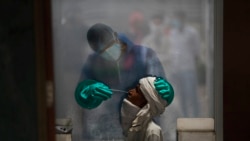A new coronavirus first appeared in Wuhan, China, about one year ago. It quickly spread around the world. The virus causes the disease COVID-19 which is blamed for causing more than 1.8 million deaths around the world and widespread economic damage.
Each nation has its own story of how it dealt with the spread of the coronavirus. News of promising vaccines and medicines are bringing hope, but a large increase in the number of cases remains a problem.
As 2020 came to an end, the Associated Press gathered stories about the crisis from its reporters in several countries. Here are shorter versions of what they wrote.
Brazil
In Brazil, President Jair Bolsonaro criticized quarantines. He said closing businesses would harm the economy and punish the poor. He did not take the virus seriously enough and claimed that nothing could stop 70 percent of Brazilians from catching it. He would not take responsibility when people became sick. Instead, Bolsonaro provided economic aid to ease the pain of the pandemic.
China
In China, workers have returned to factories and offices, students are back in the classroom and people are gathering at restaurants. In the cities, wearing a face covering is not required outside of subways and other crowded places. Life is back to normal in China, the country where the coronavirus appeared one year ago. China's ruling Communist Party has lifted some of the strongest anti-disease controls ever.
Germany
Germans eased restrictions in the summer. That was the result of widespread testing for the virus which won wide praise. It brought the number of daily COVID-19 cases down from a high of more than 6,000 in late March to the few hundreds by the warmer months.
But people stopped following the rules all the time, so the numbers began to climb to nearly four times the March daily record. Germany is now in a new lockdown as it tries to bring the pandemic back under control.
India
A nation of 1.3 billion people, India is likely to become the country with the world's highest coronavirus numbers. It established a nationwide lockdown early on. But the number of cases went up quickly as restrictions eased and its weak public health system struggled to deal with the situation. There are questions about its unusually low death rate. In addition, India's struggling economy recorded its worst performance in at least 20 years.
Iran
At the start, Iranian officials downplayed COVID-19. They denied the rising number of infections. They refused to close Muslim religious centers and delayed closing businesses. The coronavirus pandemic has worsened in Iran in the course of the year. Now the virus has sickened and killed top officials. It is perhaps Iran's greatest threat since the unrest and war that followed its 1979 Islamic Revolution.
Israel
Israel went into its second nationwide coronavirus lockdown in September. People observing the most traditional form of religion did not obey safety rules and crowded together for ceremonies and services, so COVID-19 cases continued to rise. This gave others the idea that the community puts more importance on religion over science and cares little about the greater good.
Italy
In February, Italy became the center of COVID-19 cases in Europe. Italy’s wealthy health care system nearly collapsed under the weight of the pandemic. The lessons of that earlier wave did not help the much older population of the country in September. The number of infections rose again and many of those victims were older people. Hospitals once again were almost at a breaking point.
Japan
The COVID-19 pandemic in Japan started in February when a cruise ship, the Diamond Princess, returned to its home port near Tokyo. The boat carried people sick with the virus. More got sick as the passengers stayed on the ship for weeks. Many criticized how health officials handled that quarantine. Wearing face coverings is a part of daily life in Japan. There are also strong border controls.
The 2020 Tokyo Olympic Games were canceled, but the country hopes to hold them next summer.
Kenya
Usually, young people have less serious coronavirus infections. But the effects of the pandemic in Kenya have fallen hard on the young. Some children were forced into hard labor and prostitution. The schools have closed until 2021. Babies were born in poor conditions. Growing economic pressures and closed schools hurt millions of Kenyan children.
South Africa
In the world's most unequal country, the disease hit the poor the hardest. Unemployment rose to 42 percent. But South Africa had a secret weapon. Its health professionals had fought against the epidemics of HIV/AIDS and drug-resistant TB. The country's leaders listened to their advice on how to deal with the coronavirus. So, the worst possible outcomes have not yet happened.
Spain
In Spain, many question a system that failed to prevent so many deaths. Politicians say that the system did not collapse during the first wave of infections, when the country recorded 929 deaths in a single day. But health professionals say that the actual cost was overworked staff.
New Zealand
In New Zealand, the government closed its borders and shut down nearly everything, preventing all but a few deaths.
Your turn
What do you think of the Associated Press reports? If you are online, we would like to hear from you in the comments section.
I’m Jill Robbins.
Reporters for the Associated Press wrote this story. Jill Robbins adapted it for Learning English. Mario Ritter, Jr. was the editor.
See all of The Associated Press' "A Pandemic Atlas"
What do you think of your own country’s response to the pandemic? We want to hear from you. Write to us in the Comments Section.
________________________________________________________________
Words in This Story
pandemic - n. an occurrence in which a disease spreads very quickly and affects a large number of people over a wide area or throughout the world
downplay – v. to make (something) seem smaller or less important
infectious - adj. capable of causing infection
lockdown - n. a state of isolation or restricted access put in place as a security measure.
quarantine - n. the period of time during which a person or animal that has a disease or that might have a disease is kept away from others to prevent the disease from spreading
prostitution –n. the trade of providing sex in exchange for money
epidemic –n. when a disease spreads quickly and affects large number of people














